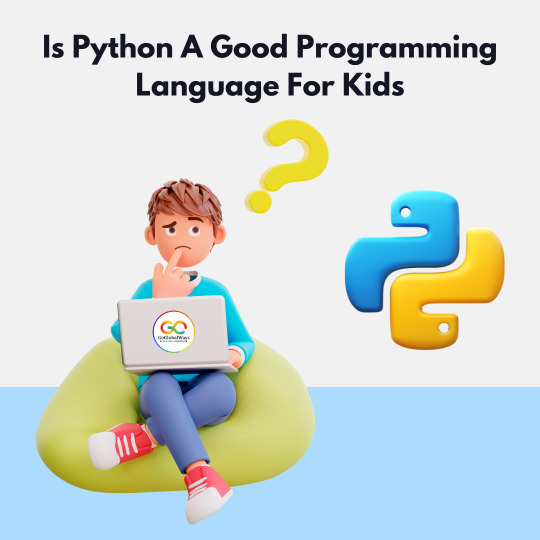#YoungDevelopers
Text
What is Future of Web Development for Kids

The future of web development for kids is promising, with an emphasis on accessibility and educational platforms tailored to their learning needs. Interactive coding environments will continue to evolve, offering engaging ways for children to learn programming languages like HTML, CSS, and JavaScript. Gamification elements will be integrated to make learning more enjoyable and motivating. Additionally, virtual reality and augmented reality tools may emerge, allowing kids to build immersive web experiences. Collaborative online communities will foster creativity and peer learning, enabling kids to share projects, seek help, and collaborate on coding challenges. With the increasing importance of digital literacy, schools and educational programs will prioritize web development as a core skill, preparing children for a future where technology plays a central role in nearly every aspect of life.
#KidsWhoCode#FutureCoders#CodingForKids#WebDevForKids#TechKids#DigitalLearning#STEMeducation#LearnToCode#CodingEducation#YoungDevelopers#WebDesignForKids#ProgrammingForKids#DigitalFuture
0 notes
Text






🌐 Unraveling the MERN Magic: A Starter's Guide! 🚀
Hey there, young MERN explorers! 🌟 Let's break down the essence of the MERN stack in a way that's easy to digest:
📌 M for MongoDB: MongoDB acts as your digital storage box 🧳, where we keep all the essential data required for your website. It's the place where information is stored securely, like a treasure chest for your web applications.
📌 E for Express.js: Express.js takes on the role of a diligent restaurant manager 🍽️ in the world of web development. It receives orders (Requests) from your users, communicates with the chef to gather data (Data), and ensures that the delightful dishes (Responses) are served promptly to your patrons (Users).
📌 R for React.js: React.js is your artistic palette 🎨. It adds the wow factor to your website, making it visually appealing and improving the overall user experience. It's like painting a beautiful canvas for your web users to explore.
📌 N for Node.js: Node.js is the powerful engine 🚀 that keeps your website running smoothly. It's the backbone of your web applications, ensuring that everything works seamlessly.
Together, the MERN stack forms a dynamic quartet that empowers you to create web applications that are both functional and visually captivating.
So, to all the young MERN enthusiasts, keep exploring, keep building, and unleash your web development creativity! 🌐✨
#MERNStack#WebDevelopment#LearnToCode#YoungDevelopers#android developer#codeigniter developer#website#webdesign#codeigniter
1 note
·
View note
Text
Congratulations!!

Congratulations students of Dronacharya College of Engineering, Gurugram for securing "AIR 6" in "HACKMOL 4.0" organized by Dr. B R Ambedkar National Institute of Technology, Jalandhar.
#congratulations#students#success#competition#HACKMOL#hackathon#developers#coders#youngdevelopers#project#solution#googledeveloperstudent#NIT#Jalandhar#workshops#seminars#technology#innovation#engineeringstudents#engineeringcollege#g20#topprivateengineeringcollegeingurugram#bestengineeringcollegeindelhincr#DronacharyaCollegeofEngineering#multipleplacement#gurugram#haryana
1 note
·
View note
Photo

LOAN IMAGE: Kevin Coscia, Kyle Jemtrud & Wilson Molitor DATE: 02/08/2024 ADDRESS: 701 Southwest Pine Island Road MARKET: Cape Coral ASSET TYPE: Multifamily ~ UNITS: 280 LENDER: Greystone (@Greystonecref) LANDLORD: Young Development BROKERS: Kyle Jemtrud, Kevin Coscia & Wilson Molitor - Greystone LOAN AMOUNT: $41,664,000 LOAN TYPE: Refinance LOAN TERMS: 10 year Fannie Mae, 5 years I/o #Miami #RealEstate #tradedmia #MIA #TradedPartner #CapeCoral #Multifamily #YoungDevelopment #Greystone #KyleJemtrud #KevinCoscia #WilsonMolitor
#Miami#RealEstate#tradedmia#MIA#TradedPartner#CapeCoral#Multifamily#YoungDevelopment#Greystone#KyleJemtrud#KevinCoscia#WilsonMolitor
0 notes
Text
3 REASONS WHY YOU SHOULD NOT WAIT FOR TRAUMA THERAPY
"There are wounds that never show on the body that are deeper and more hurtful than anything that bleeds" -- Laurell K. Hamilton
Trauma remains a conversation marred by silence and the unknown, as victims are stripped from any sense of expression. The reasoning behind this muted response may be attuned to a variety of factors: insufferable anxiety, persistent depression, and misplaced trust. With such an overwhelming onslaught of emotions, victims may find it difficult to confide in anyone, due to the fear of being a burden or resurrecting feelings from such a haunting time.
Therapists can provide an outlet of expression for these ensnared individuals by revealing the meaning behind these traumatic experiences along with methods to overcome them. Trauma therapy can provide a resolution to a pain that knows no bounds. Here are three reasons why you should not wait for trauma therapy:
Potentially traumatic experiences during childhood may lead to serious mental and physical health problems during adulthood.
Therapy may uncover the unconscious veil behind such distressing events and deduce an explanation for it that only a professional can.
There has been no sufficient evidence that therapy has worsened a patient’s trauma, but only mitigated or alleviated it.
Child abuse is an unfortunately common experience that afects millions of kids every year. In fact, within the United States, nearly 60 percent of children have been victims of sexual abuse or physical assault during a one-year period. With such youngdeveloping minds, children cope with such disruptive trauma by sealing those experiences back into the recesses of their minds, so that they withhold the image of the abuser as a “role model.” Melissa K. Runyon, a licensed psychologist, explains how “...avoidance limits a youth’s intentional processing and meaning making of their experiences and may increasingly undermine their developmental trajectory.
The negative cognitions and mood symptoms account for the development of inaccurate and/or unhealthy beliefs about the world, the self, and others” (p. 526). Runyon asserts that youth who experience such interpersonal trauma will often overgeneralize and accentuate the cynical aspects of relationships which will inevitably lead to a lack of trust or spiteful categorization. Without any source of positive reassurance, children may exhibit a continuum of PTSD symptoms that can include anxiety, depression, disruptive behavior, and substance use disorders. This ultimately translates to a higher inclination for both mental and physical impairments during adulthood, such as chronic obstructive pulmonary disease, alcoholism, and bipolar disorder. To counteract these detrimental conditions from forming, therapists can utilize cognitive techniques to bring these unconscious fears to the forefront to be fully conveyed and attenuated.
Trauma is an emotional response that is difficult to address because it forces the victim to directly confront hardship knowing the feelings of anguish, fear, and anger are all inescapable. People who care for the victims are also put in a difficult spot because their willingness to help might be dispelled from the apprehension of possibly triggering a memory that makes the victim uncomfortable. Dorit Amir, a professor at Bar Ilan University, indicates how improvisational music therapy can expose and heal unrelieved trauma in a safe, supportive environment. Amir had a client named Lisy who suffered from sexual abuse from her father which translated into a barrier for any relational intimacy in her adult life.
Through many successive sessions, Lisy was able to make a breakthrough, as Amir elucidates, “While Lisy's improvisations at the beginning stage of therapy mirrored her facade and how she organized her external world, her later improvisations mirrored her inner world” (p. 102). During the introductory sessions, Lisy would play the piano with the same intonation to indicate that she desired a controllable sense of stability, but as time went on, her playing became more frenetic whenever she heard the words “anger,” “being afraid,” and “father” which showcased how she forcibly restrained herself to maintain her picturesque image of being “normal.” By taking an active part in her own music, Lisy was able to form an intimate relationship with her new partner and she felt empowered whenever she faced a new obstacle, instead of ignoring it. Music therapy has proven to be monumental for Lisy’s physical and mental state, but that shouldn’t disregard other therapeutic practices that elicited the same success, such as prolonged exposure and cognitive processing.
The study of therapy involves the enactment of multiple theories, whether that be psychodynamics, behaviorism, cognitive psychology, etc. The integration of such a broad approach allows the therapist the flexibility to formulate a plan that is best suited for his client. Everyone is psychologically wired to portray a certain character when in public and in reserve and it's up to the therapist to determine how these traits are formatted through a trauma-focused lens. However, a recurring theme of trauma therapy would incorporate the retelling of said trauma to wholeheartedly reveal the motivation behind certain actions, as well as a pathway to improve PTSD symptoms.
The retelling of said trauma is often recognized as prolonged exposure or PE, which improves the client’s ability to process the traumatic memory and decrease her anxiety, distress, and excessive fears. There are times when the memory becomes too intense and other practices, such as cognitive processing and stress inoculation training are implemented to help quell such evasive consternation. Kayla K. Gurak, a licensed psychologist from Nova Southeastern University, exclaims “...the addition of other treatment components does not lessen the efficacy of exposure-based treatments nor does it have detrimental effects on the patient or patient outcomes (Kehle-Forbes et al., 2013). In fact, several studies which utilized integrated treatments have demonstrated significant improvements in PTSD, depression and anxiety symptoms, and overall mental health functioning” (p. 3).
Gurak delineates how the improvisational method of treatment allows for better outcomes when it comes to emotion regulation, interpersonal problems, and mental health functioning. Such a malleable approach may also prove to be beneficial to the therapeutic alliance between the therapist and the client, as the client will view herself as an active participant rather than a bystander.
Trauma therapy is a collaborative efort that embraces vulnerability, fear, and anxiety and interjects it with a procedure that ensures self-confidence, empowerment, and hope. People may be wary about the eƦectiveness that therapy instills, but the intention for the client’s improved well-being should not be dismissed. Through a better understanding of the human consciousness, young and old, trauma therapy would only help millions of victims regain control of their lives.
Works Cited
Amir, Dorit, D.A., ACMT, Giving Trauma a Voice: The Role of Improvisational Music Therapy in Exposing, Dealing with and Healing a Traumatic Experience of Sexual Abuse, Music Therapy Perspectives, Volume 22, Issue 2, 2004, Pages 96–103, https://doi.org/10.1093/mtp/22.2.96
Gurak, K. K., Freund, B., & Ironson, G. (2016). The Use of Both Prolonged Exposure and Cognitive Processing Therapy in the Treatment of a Person With PTSD, Multiple Traumas, Depression, and Suicidality. Clinical Case Studies, 15(4), 295–312. https://doi.org/10.1177/1534650116641214
Runyon, M. K., Risch, E., & Deblinger, E. (2019). Trauma-focused cognitive behavioral therapy: An evidence-based approach for helping children overcome the impact of child abuse and trauma. In Innovations in CBT for Childhood Anxiety, OCD, and PTSD: Improving Access and Outcomes (pp. 525-549). Cambridge University Press. https://doi.org/10.1017/9781108235655.026
#Trauma therapy#therapy#trauma#mental health#Eye Movement Desensitization and Reprocessing#what is trauma therapy for adults#trauma therapist#what are the best practices for trauma treatment#trauma therapy for children#trauma counselling techniques pdf
3 notes
·
View notes
Text
Is Python A Good Programming Language For Kids

Python is great for kids! Its easy-to-understand code helps beginners learn programming without confusion. They can start with fun projects like games and stories and then move on to cooler stuff like making websites, analyzing data, and even creating artificial intelligence! There are lots of resources out there to help kids learn Python, like tutorials and forums made just for them. Many schools teach Python too, so it's easy to learn in class or at home. Learning Python for kids is not just fun it can also open up lots of job opportunities in the future because it's used in many different industries. So, if kids want to learn programming, Python is a fantastic choice! It's simple, and versatile, and there's plenty of help available.
#PythonForKids#CodingForKids#KidsWhoCode#ProgrammingFun#PythonProjects#LearnPython#STEMforKids#FutureCoders#PythonProgramming#CodingSkills#YoungDevelopers#CreativeCoding
0 notes
Text
The Future of Web Development for Kids

The future of web development for kids is promising, offering a gateway to digital literacy and creativity. As technology continues to advance, web development skills become increasingly crucial. Learning to code and create websites empowers children to navigate the digital landscape with confidence. Kid-friendly coding platforms and tools make the learning process enjoyable, engaging, and accessible, fostering a love for problem-solving and design. With the rise of interactive and immersive online experiences, understanding web development provides kids with the ability to shape and contribute to the evolving internet. As the demand for digital content and applications grows, proficiency in web development opens doors to various career paths. Additionally, it nurtures essential skills such as critical thinking, collaboration, and adaptability, preparing kids for a future where technology plays a central role in nearly every aspect of life. In essence, the future of web development for kids not only aligns with technological advancements but also cultivates a generation of tech-savvy and innovative individuals.
#FutureDevelopers#CodeForKids#WebDevForChildren#DigitalLiteracy#CodingFun#YoungDevelopers#WebDevelopmentSkills
0 notes
Text
Web Development Course For Kids | GoGlobalWays

GoGlobalWays offers an exceptional web development course for kids, providing a dynamic and engaging learning experience. Tailored for young learners, this program stands out for its interactive approach and age-appropriate content. The curriculum is designed to instill fundamental coding concepts in a fun and accessible manner, ensuring that kids grasp the basics of web development with ease. The course introduces children to HTML, CSS, and JavaScript, the building blocks of web development, through hands-on projects and creative exercises. GoGlobalWays emphasizes a practical learning approach, enabling kids to create their own simple websites and applications, fostering a sense of accomplishment. With experienced and supportive instructors, the program encourages collaborative learning, allowing kids to share ideas and solve problems together. The flexible nature of the course accommodates various learning styles, ensuring that each child can progress at their own pace. GoGlobalWays aims not only to teach coding skills but also to inspire a passion for technology, laying a solid foundation for future success in the rapidly evolving digital landscape.
#KidsCoding#WebDevelopmentForKids#CodingFun#CodeCreativity#YoungDevelopers#DigitalLearning#GoGlobalWays
0 notes